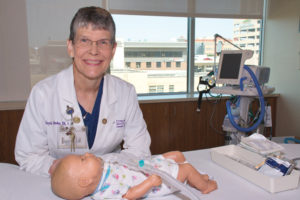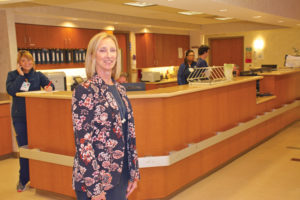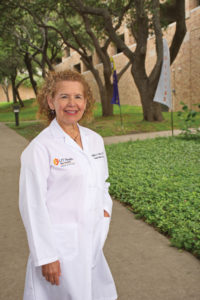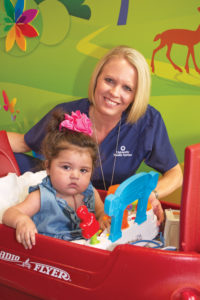Promote Innovation, Education and Quality Care for Local Patients
From education to research, nurses in San Antonio are making a huge impact
in the quality of patient care in this community. As we spend time with four
leaders in the nursing profession, residents should feel reassured San Antonio
is a city with excellent medical care. They work alongside physicians and nursing
students to raise the bar and offer new ideas, innovations and peace of mind.
Shannon Friesenhahn
On this day in mid-April, there’s a lot of activity on the 9th floor of University Hospital. Crews are putting on the finishing touches on the new inpatient Pediatric and Congenital Cardiac Care Unit (PCCU), part of the Children’s Health Heart Center (CHHC), which relocated here three years ago. And it seems everyone has a question for the unit’s director, Shannon Friesenhahn, an RN with a master’s degree in nursing administration, who is overseeing the renovation. “I think I’ll add ‘construction manager’ to my résumé,” she quips, as she leads a couple of visitors on a quick tour of the site. The new unit has 18 “variable acuity” rooms where young patients can receive every level of care needed, including intensive care.
“It’s a unique concept,” explains Friesenhahn. “We provide variable acuity care in their rooms so that the kids don’t have to be moved all over the hospital, and they have the same team of health providers taking care of them throughout their stay.” A team typically consists of physicians such as a cardiologist and cardiothoracic surgeon, nurses, child-life specialists, and other specialized personnel. But it is the nurses who stay with the patients 24/7, says the director. “Their ability to assess the patient’s situation and notice subtle changes is absolutely vital.”
Friesenhahn also points out that the new facilities will enhance the family-centered aspect of care, making it possible for parents to stay on the same floor, and even in the same room, to comfort and support their child. This is especially important for families who do not live in San Antonio, as is the case with quite a few. CHHC — which includes the outpatient clinic and family accommodations in addition to PCCU — has patients from all over the south-central Texas region. Since the pediatric cardiac program was started at University Hospital in 2014, the number of patients has increased by 40 percent while the number of nurses under her supervision has jumped from 6 to 38. Until the new facility opens, current patients are temporarily treated on the 10th floor.
As a mother herself, the PCCU director is acutely aware of the anxieties of the patients’ families. As we walk toward her office on the 10th floor, she stops several times to chat with colleagues about their little patients whom she knows by name and health condition. “These patients are the sickest, and I get to know them and their families and develop a bond with them. I absolutely get attached to them,” she says. “After they leave, they come back for checkups and visits, and once a year we have a reunion party with all of them.” In addition to Texas kids, the heart center provides lifesaving surgeries to children from developing countries who are sponsored by the philanthropic HeartGift program.
Friesenhahn made the decision to go into a health care profession early in life when she performed her first “healings” by pulling thorns out of her father’s hands. They lived in the country and thorns were a common occurrence. “He seemed so happy after I did that,” she recalls, “that it gave me a sense of what it means to alleviate pain or distress.,” Her first job was as a staff nurse assisting with child birth. In her current position, she is in a leadership role, supervising the nursing staff, overseeing the logistics of moving into a new space, developing the budget, managing the unit as a whole and, as already mentioned, overseeing the renovation itself. It was a challenge that stretched her “pretty thin,” but she wouldn’t have it any other way, she notes. “The challenge of it is also the satisfaction. I love the patient care aspect of it, but working on building a team and working on this entire project has been very rewarding.”
Research has shown that the combination of family-centered care and the benefits of having a single team of providers for each child result in considerably better outcomes than the traditional hospital model, something Friesenhahn takes great pride in. Still, not every child can be helped, and that can be heartbreaking. To work where she works can clearly bring both great joy as well as great sadness. So, how does she detach from all the worries and anxieties of the job at the end of the day?
“I don’t,” comes the prompt reply. “Some people may call it unhealthy, but this is my passion. I’ll sit at home and cry sometimes. My daughter comes first, of course, but these kids and their families are very important to me.”
Gayle Dasher On the third-floor of the Christus Santa Rosa hospital complex downtown, there are several rooms occupied by very special “patients.” They breathe, blink, cough, and exhibit signs of illness at the touch of a button, or more accurately, at the click of a computer mouse. They are human-like mani-kins that can do pretty amazing things. For instance, there’s Noelle, a female manikin who can give birth to a “baby.” There’s “baby” Hal, who cries and flails his arms and legs, and there’s Sim Man, who can have a seizure on command. Called the Simulation Lab, the facility is used for training of staff nurses and other personnel employed by the Christus Santa Rosa Health Care System (CSRHCS).
On the third-floor of the Christus Santa Rosa hospital complex downtown, there are several rooms occupied by very special “patients.” They breathe, blink, cough, and exhibit signs of illness at the touch of a button, or more accurately, at the click of a computer mouse. They are human-like mani-kins that can do pretty amazing things. For instance, there’s Noelle, a female manikin who can give birth to a “baby.” There’s “baby” Hal, who cries and flails his arms and legs, and there’s Sim Man, who can have a seizure on command. Called the Simulation Lab, the facility is used for training of staff nurses and other personnel employed by the Christus Santa Rosa Health Care System (CSRHCS).
“The lab has allowed us to bring education to a whole new level,” says Gayle Dasher, a Ph.D. in nursing, and the person most responsible for the development and design of the lab. “They can learn without real patients. I tell them, ‘If you are going to make a mistake, make it here. And I think it’s fun for them.”
Dasher, whose current title is director of clinical practice and standards, has been a nurse for 35 years, though her education in the biological and healing sciences started even earlier. Her first degree was a BA in biology, which was followed by a couple of years in dental school. By the third year, the young woman was ready to jump ship to follow her heart into nursing. “That first day in the (nursing school) classroom, I told myself, ‘This is where I belong,’” she recalls. And she has never looked back. After serving in the Army for six years, where she was exposed to patients from all over the world suffering from all sorts of injuries and illnesses, Dasher became “well versed in a range of treatment modalities,” eventually choosing to specialize in neurological care. To this day, she lectures in this area, which was also the subject matter of her Ph.D. dissertation. “I joined the Army to see the world and they put me at BAMC,” she jokes, but she “loved” the experience and met her husband during that time.
Her Army service completed, the native San Antonian joined the Santa Rosa system, where her first job was as the coordinator of critical care development. Over the years, Dasher has made a huge cumulative contribution in a number of leadership positions. Her boss, Patty Toney, the system’s chief nurse executive, called her “my healthcare hero,” saying that Dasher “is considered by many, myself included, to be the heart of nursing practice at Santa Rosa.”
In her current role, Dasher is responsible for coordinating the implementation of care standards throughout the organization and, overseeing both nursing research and the nursing residency program that she was instrumental in developing. Called the Versant Residency Program, the hands-on education helps new graduates navigate the transition between academic learning and hospital practice. Dasher also oversees other educational efforts, which focus on specific practices and conditions, and works with various teams throughout the system to address issue in care delivery.
As leader, she was recently helping the entire nursing staff of the Medical Center Santa Rosa adult hospital to prepare for a special. non-mandatory but prestigious accreditation, known as the Magnet designation, awarded by the American Nurses’ Credentialing Center. “This is official recognition for care facilities that deliver superior patient outcomes,” explains Dasher with satisfaction. “The surveyors stayed for three days and talked to nurses and looked at everything. I spent three weeks over there, helping them to put the stories they wanted to tell in a presentation format. Though we won’t know the result for a couple of months, we feel good about it. One surveyor said to me ‘I feel like I’ve been on a spiritual retreat.’”
This amazing woman and life-long Catholic has recently gone back to school to become a geriatric nurse practitioner. The move was inspired by the nurses in her mother’s nursing home. “I regularly visited my mother, who had Alzheimer’s, and I observed the nurse practitioners who checked on the residents,” she says. “They didn’t just check the vital signs; they stayed and talked to the patients. I thought, that was the right way to do it. So, that motivated me, and also the desire to get back to direct patient care. And I love it.”
So every Friday afternoon, she heads to one of the Catholic nursing homes in town, including the retirement home of the Sisters of Divine Providence, some of whom were her teachers in elementary school. “It’s humbling for me, and rewarding, to feel like I am giving something back to them. I hope they are proud of me and feel like they have done a good job.”
Susan Griffin “We are a faith-based organization, and our nursing mission is aligned with the mission of the entire system, which is to serve humanity to honor God,” says Susan Griffin, chief nursing executive for the Methodist Healthcare System. With that in mind, the 3,500-strong nursing staff has adopted the system’s ICARE motto, which stands for integrity, compassion, accountability, respect and excellence. “That’s who we aim to be and why we are here, to serve our patients and the community,” adds Griffin, who has been a nurse since 1978. Prior to joining MHCS in early 2015, she held a variety of executive-level positions in Austin, The Woodlands, Conroe, and other cities.
“We are a faith-based organization, and our nursing mission is aligned with the mission of the entire system, which is to serve humanity to honor God,” says Susan Griffin, chief nursing executive for the Methodist Healthcare System. With that in mind, the 3,500-strong nursing staff has adopted the system’s ICARE motto, which stands for integrity, compassion, accountability, respect and excellence. “That’s who we aim to be and why we are here, to serve our patients and the community,” adds Griffin, who has been a nurse since 1978. Prior to joining MHCS in early 2015, she held a variety of executive-level positions in Austin, The Woodlands, Conroe, and other cities.
The slim, friendly executive proudly points out that her organization is “on the Malcolm Baldridge Award journey,” which means looking at all aspects of the operation to identify improvement goals. The award was established by the U.S. Congress and bestowed on enterprises that demonstrate quality and performance excellence in seven areas, including leadership, customer/patient treatment, workforce engagement and results. It is a good framework for enhancing quality across the board, notes Griffin, who helped her former employer, St. David’s Healthcare in Austin, to get the award in 2014. And that’s just one feather in her professional cap. Her CV is positively packed with accomplishments on many fronts.
The four goals that she set out to achieve across the eight Methodist facilities in town are spelled out on a blackboard in her office: to achieve top-tier patient satisfaction; to reach 12 percent or less turnover in RNs; improve nurses’ engagement, and to reduce hospital-acquired conditions. Retention of nurses is a special challenge.
“Engagement and retention are tied together. The millennial generation tends to be mobile, and today there are so many other places where they can work besides hospitals,” she explains. To increase job satisfaction, a multifaceted approach was adopted that beefs up clinical education and provides a culture for professional growth. “We have a system of rewards and recognition for our staff. They can be promoted, make more money, participate on committees, etc. That has improved retention. The national turnover rate is around 18-29 percent; ours is 14.1 percent. We plan to bring it further down.”
After listening to staff nurses, another change she has initiated is to simplify the electronic documentation that nurses must handle. “That’s a big part of why I am in this role. A leader should have the courage to step up and remove barriers that employees face in their work. I no longer take care of patients, but it’s my job to identify the needs nurses have so that they can take better care of patients,” she says emphatically.
For Griffin, nursing was definitely a calling. The loss of her mother at age 10 taught her what suffering was. To be a patient means to suffer, she observes, and she decided early on that her calling was “to help people who suffer.” Married to a psychotherapist and a mother of three grown children, Griffin has clearly inspired her kids to choose helping professions – two are nurses and the third a physical therapist. The entire family is active in international missions, where they often help the poorest of the poor who live in deplorable conditions. Working through a Christian organization, they played a major role in establishing a clinic in Arusha, Tanzania, which now serves some 3,000 patients a month. “I would definitely encourage (Americans) to get out of their comfort zone and take a trip like that.”
Adelita Cantu Professor Adelita Cantu, Ph.D., has her own simulation lab for her nursing students. It may not feature manikins like Santa Rosa’s, but it simulates another kind of real-life situation that patients find themselves in – living in poverty. As a specialist in public/community health, Cantu wants future nurses to understand how environmental and social conditions influence health and longevity.
Professor Adelita Cantu, Ph.D., has her own simulation lab for her nursing students. It may not feature manikins like Santa Rosa’s, but it simulates another kind of real-life situation that patients find themselves in – living in poverty. As a specialist in public/community health, Cantu wants future nurses to understand how environmental and social conditions influence health and longevity.
“Life expectancy is directly correlated to the zip code you live in,” says the professor. “Where we live, work and play affects our health in a myriad of ways. These social and environmental determinants are the focus of public health. In other words, there are other factors besides our personal responsibility that influence our health. Here in San Antonio we have large pockets of health disparity based on where people live.”
Developed by the Missouri Community Action Network and brought to the UTHSCSA by Cantu, the poverty simulation program is an immersive experience where participants “role-play the lives of low-income families.” In Cantu’s classes, students have to figure out how to use public transportation to get to work or a doctor’s appointment, how to pay their bills and not get evicted, how to get food to the table, and deal with all the stressors that poor people live with. No wonder health care is not high on their priority list.
“I want our student nurses to know that the patient they’ll be seeing in the hospital for, say, diabetes, is bringing with him all those influences that helped create his illness,” explains Cantu, whose heart is clearly involved in this issue. “The nurse has to be aware that the patient may not have insurance, or doesn’t have transportation to get to the pharmacy to pick up his medication or the money to pay for it. I want them to understand that help is so much more than what happens in the hospital.” Thus-educated nurses can direct the patient to appropriate community resources for help.
Ultimately, Cantu would like her students to follow her example and become involved with nonprofits and other initiatives that aim to improve public health. She is on the board of the Diabetes Association, which partners with YMCA to run camps for West Side youths that teach the youngsters and their families about healthy living. She personally helped develop the curriculum and performs the program evaluations. But that’s just one of her many volunteer activities. Working with senior centers on the West Side, for instance, is also a big priority for her, and she’s always ready to partner with community-based agencies in pursuit of health-related goals.
Born and raised on the West Side, Cantu started her career as a hospital nurse, which did not agree with her. Fortunately, the young woman soon discovered her true niche in public health. She had a long career in the University Health System before joining UT Health. To advance further in the academic setting, she earned a Ph.D. in 2006 and has just become a tenured professor in April of this year. In 2016, the health science center honored Cantu with the Presidential Teaching Excellence Award, one of the many honors and recognitions the professor has received over the years.
She still lives not far from where she grew up, in the Woodlawn Lake area, with her husband of 13 years, John Cantu, and takes good care of her own health by going to the gym, bicycling and taking walks. The improvements the city has made around the lake and in other parks and public spaces is a good step toward getting people to embrace fitness, but it’s going to take time for obesity and diabetes rates to show substantial declines, she observes. Nevertheless Cantu is certainly not giving up.
“We still need to build a culture of health and teach people how healthy practices fit into their lifestyle… I am from the barrio; I feel an affinity for the barrio and the West Side, and that’s where I want to make the most difference,” says this passionate advocate for health and compassion.
By Jasmina Wellinghoff
Photography by Martin Waddy





